28
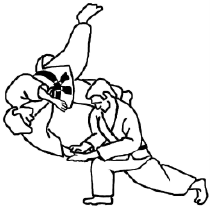
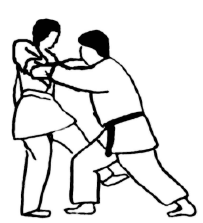
Sumi otoshi
Attempt Shiho nage, Uke pulls knife hand back to rear. As opponent thrusts forward, by stepping forward with right foot, and to the right, move into right posture, wrists touching, hands spread apart and open, left on top of right.
Grip the wrist and forearm of the knife hand and, as he begins to resist the catch, step smartly past his right foot with your left, extend the forearm back and raise his elbow as high as possible, before he can move his left leg to gain balance cast the wrist in a fishing motion driving him backwards toward the floor.
Tenkai kote hineri
Attempt Sumi otoshi, your opponent steps back to foil the balance break. Step forward with your right foot and place it outside the opponent’s right foot. Keep the same wrist position, left hand on the back of the opponent’s right hand with the fingers in the palm. Extend both arms forward raising your opponent’s right elbow to the horizontal. Maintain the hand position and pivot on both feet to your left, forcing the opponent to break balance forward. Step forward with right foot and pivot on left to face opponent. Keep the left hand on the wrist, place the right on the opponent’s extended forearm and step back wards with left foot forcing the opponent to the ground in prone position. Apply Yonkkyo to finish.
29
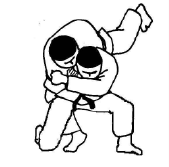
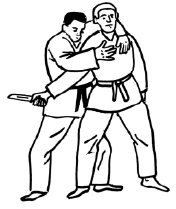
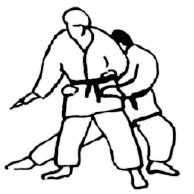
Open Catch (Outside)
Seoi otoshi
As opponent thrusts forward move to the forward left in left posture, attempt an open catch on the wrist. As the opponent pulls back and also steps to foil a hold, maintain the grip on the left forearm with your left hand, step forward and place your right foot next to his, rotate your left leg behind you so that your back is now touching his chest simultaneously placing the crook of your right arm tightly under his right armpit. Continue the circular motion and throw with shoulder throw as in basic release.
Ushiro ate
Attempt Seoi otoshi, Uke pulls knife hand back.
As opponent begins to retreat, release the grip on the arm and move forward in left posture and place your left leg behind his right. Put the left side of your chest against the rear right of his chest, reach round his back with your left hand and place it over the left shoulder and down toward chest, right hand to chest on opponent’s right. Left foot moves to centre position behind opponents legs. Keeping tight grip draw opponent toward own chest, rotate body so that opponent is forced to rear over left leg.
Tani otoshi
Attempt Ushiro ate. The opponent leans forward to foil the rear pull. Step with the left foot past the opponent’s left foot, move your hips past your opponents so that you are on the opponent’s left side, leave the right foot trailing.
Reach around the opponent’s waist and fall down onto your backside. Pull the opponent to his rear making him rear roll over your leg. Turn to face your opponent as you land on the floor.
30
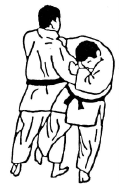
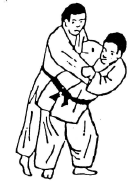
Nage Waza
(Throws)
Hold opponent with left hand on right sleeve just below the elbow and right hand at left lapel at centre of chest.
The throws are split into combinations of consecutive forward and rear.
O soto gari
Step past your opponents right foot with your left, drive his right hand back by pushing his elbow toward the floor behind him. Move the right hand past his left shoulder, lean forward so that the right side of your chest is in full contact with the right side of his chest. Your opponent should now be leaning back toward his right rear with all the weight on his right foot. Keeping your own weight on your left foot raise your leg so that it is on the outside rear your opponent then sweep the leg back in a big arch without the foot touching the floor, the back of the right knee driving into the back of your opponents right knee, thus
driving his back to the floor.
O goshi
Keeping your grip on the sleeve, pull toward yourself with the left hand, simultaneously riding the right hand up and around the collar, step in with the right foot toward the inside or your opponents right foot, rotate on the foot and bring both feet in line so that your back is completely against your opponents chest and bringing your right hand as close to your own chest pull your opponent toward you. Continue to rotate and pull your opponent over your hips and onto the floor in front of you.
31
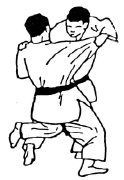
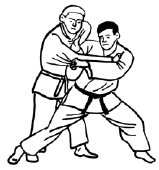
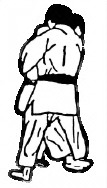
O uchi gari
Attempt O-goshi, your opponent resists by pushing the hips forward to push you off balance. Change the direction of your pull from forward to his left rear, left hand on sleeve lifting up, right hand driving back keeping hold of lapel.
Rotate your hips to face your opponent and hook the back of your own right knee behind the back of his left knee, continue to circle the foot and your opponent will fall onto his back.
Tai otoshi
Facing your opponent, pull forward with both left and right hands. Put your right foot toward his right foot and pivot, swinging the left foot in line but well outside of your opponent. As he begins to step forward to regain balance move your right foot across in front of his so that the calf is in front of his shin. Continue to pull him forward by pulling with the left and driving in front of you with the right, forcing him to roll over the leg and onto his back.
Ko uchi gari
Fully attempt Tai otoshi but your opponent manages to step over the outstretched leg.
Turn your instep toward your opponents heel and contact the heel in a sweeping motion
forward breaking his balance and forcing him backward to the floor.
32
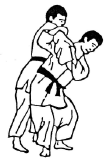

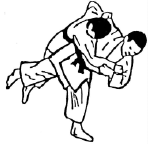
Seoi nage
Move in exactly as for O-goshi, but place the crook of the right arm tightly under your opponents right armpit. Continue the circular motion, spread the knees to squat down and lean forward by pulling with the left hand and driving the right elbow up. Your opponent will be thrown over the small of your back and onto the floor.
Ko soto gari
Hold lapel and sleeve. As you pull forward your opponent resists by leaning backward. Step to your left with your left foot and then follow with the right so that you are completely in line and to his right side, pull the right hand across his chest and drive the left elbow to the rear to break balance. Sweep the back of his right heel as in Ko-uchi gari, throwing him onto his back.
Harai goshi
Move in exactly as for O-goshi, as your lean forward to throw raise the right leg forward then sweep it backward in a large circular motion on the outside of your opponents right leg, pointing your toes to assist in drive. Try to make thigh to thigh contact only. Maintain pull and drive with hands. Opponent will rotate onto his back.
33
Taiho Jutsu
(Junior Kyu (Mon0 Grading Syllabus) Revision The Junior syllabus is exactly the same as the senior. However, to facilitate Mon, techniques required in grading examinations are graduated up to the full belt (Kyu) A Junior must attain the minimum age for a specific grade. This limit will be strictly adhered to. To qualify to attend a grading, a junior must have held the grade prior for a minimum of 3 months. Each grade must be obtained consecutively.
White
10 yrs
Yellow
11 yrs
Orange 12 yrs
Green
13 yrs
Blue
14 yrs
Brown 15 yrs
On attainment of 16 years the Junior grade will be accepted as a Senior grade but as Lower if 3rd Kyu (Green), 2nd Kyu (Blue) or 1st Kyu (Brown).
Grading examination rules the same as Senior examinations will apply and include the requirement for advancement.
White
(6th Kyu)
Granted unconditionally
White + 1 Yellow
Ukemi, Ground defence, Ude gatame, Kote hineri White + 2 Yellow
Kote mune gatame, Kote gatame, Ushiro kote gatame, Ude garami White + 3 Yellow
Kote gaeshi, Waki gatami, Ushiro otoashi, Seoi otoshi Yellow (5th Kyu)
Oshi taoshi, Ushiro ate, Gyaku ude garami, O soto gari Yellow + 1 Orange
Ashi mune ate
Yellow + 2 Orange
Ashi hiza ate
Yellow + 3 Orange
Ude garami (Hidari)
Orange (4th Kyu)
Ude garami (Migi)
Orange + 1 Green
Kesa gatame, Kata gatame
Orange + 2 Green
Kami shiho gatame, Yoko shiho gatame
Orange + 3 Green
Ude garame, Ude hishigi juji gatame
Green (3rd Kyu)
Ashi kensetsu, Renraku waza
Green + 1 Blue
Tenkan wake gatame, Gyaku gamae ate, Ushiro wake gatame Green + 2 Blue
Gedana ate, Kote gaeshi, Ai gamae ate, Ude garami Green + 3 Blue
Hiki taoshi, Shiho nage, Sumi otoshi, Tenkan kote hineri Blue (2nd Kyu)
Seoi otoshi, Ushiro ate, Tani otoshi
Blue + 1 Brown
O soto gari, O goshi
Blue + 2 Brown
O uchi gari, Tai otoshi, Ko uchi gari
Blue + 3 Brown
Seoi nage, Ko soto gari, Harai goshi
Brown (1st Kyu)
Kezure kesa gatame, Ushiro kesa gatame
Brown + 1 Black
Shomen ate, Ai gamae ate, Gedan ate, Ushiro ate Brown + 2 Black
Oshi taoshi, Ude gaeshi,Hiki taoshi, Ude garami Brown + 3 Black
ake gatame, Kote hineri, Kote gaeshi, Tenkan kote hineri 34
Taiho Jutsu
(Kyu Grading Syllabus) Revision 3/96
Yellow belt
Orange belt
Green belt
Blue belt
Brown belt
5th Kyu
4th Kyu
3rd Kyu
2nd Kyu
1st Kyu
3 month
3 month @
6 month @
6 month @
9 month @
attendance
5th Kyu
4th Kyu
3rd Kyu
2nd Kyu
Breakfalls
As 5th Kyu
As 4th Kyu
As 3rd Kyu
As 2nd Kyu
(Ukemi)
+
+
+
+
For Green -
For Blue -
For Brown -
Front
Hanbo
Rear
(Short Stick)
Kesa gatame
Tanto Dori
Nage waza
Sides -
Kata gatame
(Knife taking)
(throws)
(left, right)
Ashi mune ate Kami shiho-
Rolling -
Ashi hiza ate
gatame
A+D
O soto gari
(left, right)
Ude garami
Yoko shiho -
Tenkan wake gatame
O goshi
(hidari - left)
gatame
Gyaku gamae ate
O uchi gari
Migi - right
Ude garami
Ude garami
Ushiro wake gatame
Tai otoshi
Hidari - Left
(migi - right)
Juji gatame
XB
Ko uchi gari
Gedan ate
Seoi nage
+
+
+
Kote gaeshi
Ko soto gari
Running line
Ashi kansetsu Ai gamae ate
Harai goshi
Ground defence
(leg locks)
Ude garami
+
OC - i
Ne waza
Ude gatame
1 x 1
All techniques Hiki taoshi
(groundwork)
Kote hineri
Migi
Shiho nage
Kezure kesa -
+
All techniques
Sumi otoshi
gatame
Kote mune-
Migi + Hidari
+
Tenkan kote hineri
Ushiro kesa -
gatame
Running line
OC - o
gatame
Kote gatame
Seoi otoshi
Ushiro kote-
+
Ushiro ate
+
gatame
1 x 2
Tani otoshi
1 x 4
Ude garami
+
+
For Green +
Randori
For Brown +
Kote gaeshi
4th kyu
+
9 month @
Waki gatame
1 x 3
Brown -
Ushiro otoshi
For Blue +
Seoi otoshi
6 month @
6 month @
+
+
Green -
Blue -
Nage waza
Oshi taoshi
+
(hidari)
Ushiro ate
+
Tanto randori
+
Gyaku ude-
All of 4th Kyu
(hidari)
Randori
gatame
(hidari - left)
+
Renraku waza
O soto gari
Renraku waza
+
+
1 x 4
All techniques
Renraku waza
Migi
(combinations)
The Examiner may ask for demonstration of any technique he thinks fit to assist in grading 35
Taiho Jutsu
Dan Grading Syllabus
1st Dan (Shodan)
Requirements
1yr @ 1st Kyu +
Completion of 1st Kyu syllabus plus :-
Randori-no-Kata
Gonosen-no-Kata (Ura waza)
1. Shomen ate
1. Shomen ate
-
Waki gatame
2. Aigamae ate
2. Aigamae ate
-
Oshi taoshi
3. Gyakugamae ate
3. Gyaku gamae ate -
Gedan ate
4. Gedan ate
4. Gedan ate
-
Aigamae ate
5. Ushiro ate
5. Ushiro ate
-
Tenkai kote hineri
6. Oshi taoshi
6. Oshi taoshi
-
Oshi taoshi
7. Ude gaeshi
7. Hiki taoshi
-
Tenkai kote hineri
8. Hiki taoshi
8. Kote gaeshi
-
Kote gaeshi
9. Ude garami
9. Tenkai kote hineri -
Waki gatame
10. Waki gatame
10. Shiho nage
-
Shiho nage
11. Kote hineri
12. Kote gaeshi
13. Tenkai kote hineri
14. Shiho nage
15. Mae otoshi
16. Sumi Otoshi
17. Hiki otoshi
A demonstration of 5 hidari (left) techniques as requested by the examiner Demonstration defence against 2 (open blade) edge weapon body strikes The Examiner may ask for demonstration of any technique he thinks fit to assist in grading 36
Taiho Jutsu
Dan Grading Syllabus
2nd Dan (Nidan)
Requirements :
2 years @ 1st Dan
Randori-no-kata (Hidari)
Gonosen-no-kata (Hidari)
NAGE-NO-KATA
Te waza
1. Uki otoshi
2. Ippon seoi nage (Kata seoi)
3. Kata garuma
Koshi Waza
4. Uki goshi (hidari)
5. Harai goshi
6. Tsuri komi goshi
Ashi waza
7. Okuri ashi barai
8. Sasae tsuri komi ashi
9. Uchi mata
Sutemi Waza
10. Tomoe nage
11. Ura nage
12. Sumi gaeshi
Ma sutemi waza
13. Yoko gake
14. Yoko garuma
15. Uki waza
Demonstation to be Migi and Hidari
The Examiner may ask for demonstration of any technique he thinks fit to assist in grading 37
Taiho Jutsu
Dan Grading Syllabus
3rd Dan (Sandan)
Requirements :
3 years @ 2nd Dan
Completion of 2nd Dan syllabus plus :-
Koryu-Dai-San (Aikido)
Suwari waza (Kneeling techniques)
1. Oshi taoshi
2. Gyaku gamae ate
3. Kote gaeshi
4. Ryote muchi sukui nage
5. Tenkai kote hineri
6. Shiho nage
7. Gedan ate
8. Hiji kime
Tachi waza (Standing techniques)
9. Kote mawashi
10. Uchi tenkai nage
11. Gyaku gamae ate
12. Hijime kime
13. Mae otoshi
14. Ushiro waza mae otoshi
15. Ushiro waza tenkai kote hineri
16. Mune tori kata gatame
All techniques will be demonstrated to the right. However, the examiner may ask for the demonstration of any technique on the left, either singly or in combination.
Demonstration of any weapons kata from any other martial art.
The Examiner may ask for demonstration of any technique he thinks fit to assist in grading 38
GRADING EXAMINATIONS
All gradings are to be of a national standard. To that end this is a guide to assist you to understand what system the examiner will be employing.
The examiner will be looking for two things.
1. The physical application of the demonstration of the techniques.
2. The mental application of the entrant whilst undergoing grading.
The examiner will be hard but fair, for in the assessment is the future standard of Taiho Jutsu.
No-one in any way will offer or give advice to the examiner in the acceptance of a particular technique prior to a clarification request by the examiner. His judgement is absolute. Any attempt to influence will result in the automatic failing of participant. Only the first demonstration will receive a mark.
If, in his judgement, the attitude of the entrant is such as to cause concern, then this will override any standard obtained with regard to the physical demonstration and a ‘fail’ will be given.
To assist you to understand how the marking of a grading occurs, the following is the examiners guide which will be strictly adhered to.
Every technique will be marked with points out of 10
(with the grade being attempted dictating the maximum points that can be allotted)
Entrants attempting:-
Max
Min
5th Kyu
10
50%
=
Pass
4th Kyu
10
60%
=
Pass
3rd Kyu
10
66%
=
Pass
2nd Kyu
10
71%
=
Pass
1st Kyu
10
75%
=
Pass
1st Dan
10
77%
=
Pass
2nd Dan and above
10 <
















